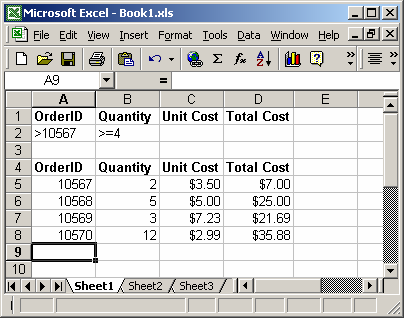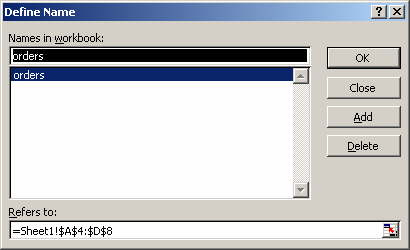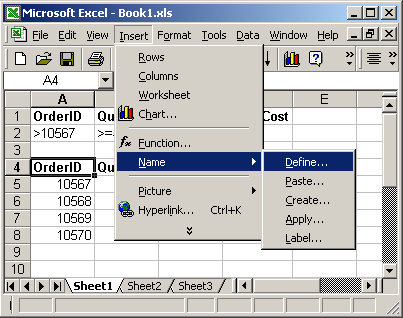Description
The Microsoft Excel DSUM function sums the numbers in a column or database that meets a given criteria.
The Microsoft Excel DSUM function sums the numbers in a column or database that meets a given criteria.
Syntax
The syntax for the DSUM function in Microsoft Excel is:DSUM( range, field, criteria )
The syntax for the DSUM function in Microsoft Excel is:
DSUM( range, field, criteria )
Parameters or Arguments
- range
- The range of cells that you want to apply the criteria against.
- field
- The column to sum the values. You can either specify the numerical position of the column in the list or the column label in double quotation marks.
- criteria
- The range of cells that contains your criteria.
- range
- The range of cells that you want to apply the criteria against.
- field
- The column to sum the values. You can either specify the numerical position of the column in the list or the column label in double quotation marks.
- criteria
- The range of cells that contains your criteria.
Applies To
- Excel 2016, Excel 2013, Excel 2011 for Mac, Excel 2010, Excel 2007, Excel 2003, Excel XP, Excel 2000
- Excel 2016, Excel 2013, Excel 2011 for Mac, Excel 2010, Excel 2007, Excel 2003, Excel XP, Excel 2000
Type of Function
- Worksheet function (WS)
- Worksheet function (WS)
Example (as Worksheet Function)
Let's look at some Excel DSUM function examples and explore how to use the DSUM function as a worksheet function in Microsoft Excel: Based on the Excel spreadsheet above, the following DSUM examples would return:
Based on the Excel spreadsheet above, the following DSUM examples would return:=DSUM(A4:D8, "Unit Cost", A1:B2)
Result: 7.99
Let's quickly explain why the DSUM function returns 7.99 in this example. The criteria for the DSUM calculation is found in cells A1:B2. This means that only those records where the order number is greater than 10567 and Quantity is greater than equal to 4 will be included in the sum calculations.So in the example above, only rows 6 and 8 meet those conditions. As a result, the DSUM adds together the Unit Cost values in only rows 6 and 8 to return 7.99 (5.00 + 2.99).Here are some more examples of the DSUM function:=DSUM(A4:D8, 3, A1:B2)
Result: 7.99
=DSUM(A4:D8, "Quantity", A1:A2)
Result: 20
=DSUM(A4:D8, 2, A1:A2)
Result: 20
Let's look at some Excel DSUM function examples and explore how to use the DSUM function as a worksheet function in Microsoft Excel:

Based on the Excel spreadsheet above, the following DSUM examples would return:
=DSUM(A4:D8, "Unit Cost", A1:B2)
Result: 7.99
Let's quickly explain why the DSUM function returns 7.99 in this example. The criteria for the DSUM calculation is found in cells A1:B2. This means that only those records where the order number is greater than 10567 and Quantity is greater than equal to 4 will be included in the sum calculations.
So in the example above, only rows 6 and 8 meet those conditions. As a result, the DSUM adds together the Unit Cost values in only rows 6 and 8 to return 7.99 (5.00 + 2.99).
Here are some more examples of the DSUM function:
=DSUM(A4:D8, 3, A1:B2)
Result: 7.99
=DSUM(A4:D8, "Quantity", A1:A2)
Result: 20
=DSUM(A4:D8, 2, A1:A2)
Result: 20
Using Named Ranges
You can also use a named range in the DSUM function. A named range is a descriptive name for a collection of cells or range in a worksheet. If you are unsure of how to setup a named range in your spreadsheet, read our tutorial on Adding a Named Range.For example, we've created a named range called orders that refers to Sheet1!$A$4:$D$8. Then we've entered the following data in Excel:
Then we've entered the following data in Excel: Based on the Excel spreadsheet above, the following DSUM examples would return:
Based on the Excel spreadsheet above, the following DSUM examples would return:=DSUM(orders, "Total Cost", A1:B2)
Result: 60.88
=DSUM(orders, 4, A1:B2)
Result: 60.88
To view named ranges: Under the Insert menu, select Name > Define.
You can also use a named range in the DSUM function. A named range is a descriptive name for a collection of cells or range in a worksheet. If you are unsure of how to setup a named range in your spreadsheet, read our tutorial on Adding a Named Range.
For example, we've created a named range called orders that refers to Sheet1!$A$4:$D$8.

Then we've entered the following data in Excel:

Based on the Excel spreadsheet above, the following DSUM examples would return:
=DSUM(orders, "Total Cost", A1:B2)
Result: 60.88
=DSUM(orders, 4, A1:B2)
Result: 60.88
To view named ranges: Under the Insert menu, select Name > Define.

No comments:
Post a Comment